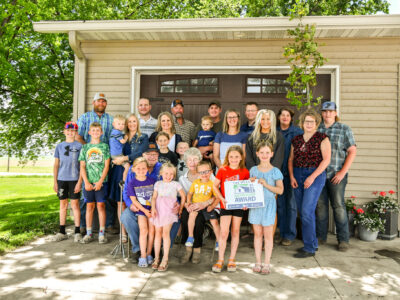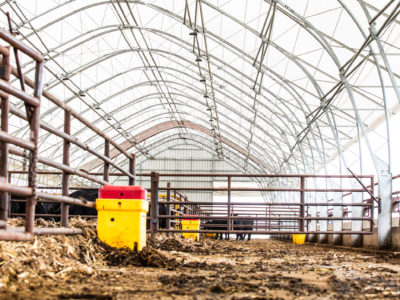Simplifying Beef Production
11-30-2015 in Cattle
The day was cold and blustery, but the cattle inside the gable-roofed barn at the Brandt and Stacy Ferry farm near Kirkman were comfortable, at a November 20 open house hosted by the Coalition to Support Iowa’s Farmers.
The 240×88-foot barn houses 600 head in five 48×56-foot pens, providing 22.4 square feet per animal with 9.5 inches per head of bunk space. A working facility and two 16-foot wide covered feed alleys make for choring ease, a priority in Brandt Ferry’s decision to erect the facility.
“I wanted to reduce labor and increase animal comfort,” says Ferry. Tired of fighting snow, cold, mud, and the routine scraping manure from pens, not to mention fence maintenance, he sought an under roof solution. “Now I handle manure two days a year, save time on day-to-day chores, and get to see the cattle happy and content.”
The Iowa Beef Systems Commander building features a catwalk for cattle viewing ease.
“The catwalk makes it easier to spot sick animals,” says Kent Mowrer, CSIF field specialist. “The data shows facilities with a catwalk have a higher pull rate, with less death loss, because sick animals are spotted a day earlier.”
It’s only one of the advantages of the design, according to Iowa Beef Systems General Manager Mark Ehresman. The gabled roof provides more protection against hard south rains than a monoslope, and more shade in summer. “Cattle are essentially wearing a leather coat,” explains Ehresman. “So heat and sun can be a problem.” Studies have shown cattle outside in the heat of summer register external body temperatures of 130 degrees. Inside this type of barn, that temp is reduced to less than 108 degrees. With ample airflow due to a four-foot roof ridge vent, cattle remain cool and comfortable.
And that means improved, consistent performance, another reason why Ferry chose to move under roof. “I can plan my marketing better,” he says. “I can contract and know exactly when they’ll be ready. And I can expect predictable performance.”
Manure management ease is another benefit of Ferry’s new facility. He consulted the Coalition to Support Iowa’s Farmers early in the process for advice and help with a manure management plan, as well as the permitting process and EQIP funding.
The barn features two 14-foot concrete deep pits to capture manure through the slatted floor. Easy Fix rubber floor mats increase cattle comfort. Ehresman says the data shows raising cattle on slats pays off in increased feed intake.
For Ferry, hoping to only handle manure once per year, the design is a dream come true. He first put cattle in the barn in July, and had five feet of manure at his first pumping. “It took about six hours,” says Ferry. “Three to stir and three to pump.” The manure was used to fertilize part of his 1,100 acres of crop ground.
Ferry also raises hogs, 2,000-plus head on the same site, so was a bit leery of the thicker beef manure. Ehresman says the challenge is to get adequate horsepower inside the pit for stirring, and Ferry says with that consideration, he can pump and directly apply the nutrient without assistance, though hiring a commercial applicator is always an option. “It works great. I injected the nutrient, and was able to no till right into the field.”
Shelby County has 372,350 acres of cropland with crop production providing 17.8 percent of the county’s jobs. Another 9.2 percent of Shelby County jobs come from livestock production, with a $103.9 million annual market value of animals raised. All totaled, agriculture in Shelby County provides 2,370 jobs, $156.2 million in wages, and $605.6 million in sales.
With his swine and beef facilities now located near his commodity and feed storage, Ferry is ready for his son to finish college and join him in the operation, adding to Shelby County’s ag production.
CSIF is a non-profit organization that assists livestock farmers who want help interpreting rules and regulations, guidance on good site locations for barns, counsel on enhancing neighbor relations and tips on how to protect the environment at no cost. For more information, call 1-800-932-2436 or visit www.supportfarmers.com.
The Coalition to Support Iowa’s Farmers was created by farmers to help farmers raise livestock responsibly and successfully. It’s a joint partnership involving the Iowa Cattlemen’s Association, Iowa Corn Growers Association, Iowa Egg Council, Iowa Farm Bureau Federation, Iowa Pork Producers Association, Iowa Soybean Association, Iowa Turkey Federation and Midwest Dairy Association.
By Terri Queck-Matzie for CSIF
Recommended News

Farming is a Family Affair
The Streit family of West Bend, Iowa, has cultivated their farm for over three decades, fostering a legacy of hard work and community support. Diane and Tony Streit, alongside their...
Read More
CSIF to Host Calving Under Roof Open House
WEST DES MOINES, IOWA – June 10, 2022 – The Coalition to Support Iowa’s Farmers (CSIF) is hosting a “Calving Under Roof Open House” at the Laura and Aaron Cunningham farm...
Read More
